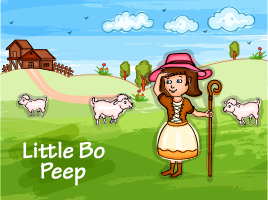Y3. Lesson 22. Two semiquavers followed by a quaver [tika-ti]
Prior learning: Ti-tika
Duration: 30 minutes
Materials: Recorders
Keywords: Beat, rhythm, singing, chanting, partners, rhymes, circle games.
Difficulty: ![]()
Prepare
Present
tika-ti
Practise
 Melodic development
Melodic development
![]() Students add a new song to their repertoire, discovering high do.
Students add a new song to their repertoire, discovering high do.
- This song is helpful in refreshing students' knowledge of high do.
- Teach the song line-by-line in a measured cadence until secure.
- Refer to the last measure where the notes are mi, re and do.
- Ask which of those three notes is the lowest and what its name is [do].
- Refer to the third measure and ask which note is the highest and on which word [friend].
- Teach that this note is high do.

 Rhythmic development
Rhythmic development
![]()
Students discover three sounds on a beat, with the last sound longer than the first two sounds.
- Students are seated.
- Lead the class in singing the song and clapping the beat.
- Using the second measure as a target phrase, ask how many beats are present [2].
- Ask how many sounds are on the first beat [3] and whether the sounds are even or uneven [uneven].
- Clap and describe these sounds as long and short.
- Clap and say 'short, short, long'.
- Teach that when there are three sounds on a beat, and the first two are short, and the other is long, the time name tika-ti is given.
- The class should clap and repeat the phrase tika-ti several times.
- Sing and clap the time names of the first two measures, i.e., ti-tika, ti-ti, tika-ti, ti-ti.
- Students should repeat after you.
- Remind students not to confuse the new time name tika-ti with ti-tika.
 Creative movement
Creative movement
![]() Students form two lines and sing and move in this line dance song.
Students form two lines and sing and move in this line dance song.
- All students will sing and keep the beat with their feet.
- Arrange students into two parallel lines (Lines 1 and 2), with everyone facing forward.
- Verse 1: Student 1 from Line 2 moves clockwise around both Line 2 and Line 1, returning to their original position.
- Verse 2: The same student repeats the clockwise route around both lines, followed by all students from Line 1.
- Verse 3: Simultaneously, Line 1 students walk counterclockwise to the end of their line and back to their starting positions, while Line 2 students move clockwise to their line's end and return to their original spots.
- When the first student of each line meets at their starting point, they face each other, join hands, and create an arch. The other students pass under this arch, circle their respective lines, and return to their starting positions.
- The first student in each line moves to the end, allowing a new student to take the front position in each line.
Verse 2: Come on, boys, let’s go find her...
Verse 3: Picking’ up paw paws, putting’ ’em in her pockets…
 Listening
Listening
![]() Students listen and identify sounds with the time name tika-ti.
Students listen and identify sounds with the time name tika-ti.
- Explain to students that they will hear some notes from different instruments.
- As musical detectives, they must discover whether each short piece of music contains the time name tika-ti.
- Students must discover the time name if the music does not contain that name.
- Play the first track. Ask if it contains tika-ti and which instrument is used.
- Repeat for the other four tracks.
- This is an excellent exercise for developing listening skills in rhythm.
 Visual learning
Visual learning
![]() Students
Students
- Project the simple graphic of tika-ti on the board.
- Ask students to copy the pattern of two short notes and one longer note.
- Remind them they are writing two semiquavers joined to a quaver in traditional names.
- Project the phrase in the score and ask students to copy the pattern.
- Ask students what the difference is between tika-ta and ti-tika.

 Instruments
Instruments
![]() Students discover a classic song in 3/4 time.
Students discover a classic song in 3/4 time.
- Teach that this song is in triple metre, which students may have investigated in previous lessons.
- Remind students that each measure of music has three beats.
- Say and repeat the count of 1 - 2 - 3, and have the class repeat after you.
- Teach that a semibreve, or half note [too], has a count of two beats. And if it has a dot after it, it has a count of three beats!
- Demonstrate the first eight measures and ask the class to repeat after you.
- When secure, teach the second eight measures and have the class repeat after you.
- When secure, have the class play all sixteen measures. As this song is more advanced, it will need more than one learning period.

 Part work
Part work
![]() Students sing a known song in canon.
Students sing a known song in canon.
- The whole class sings the song.
- Divide the class into two groups
- The first group should begin singing on your command.
- The second group sings in canon after two measures.
- Swap the two groups when secure.
 Assess
Assess
Suggested lessons
Y1. Beat II

Y1. Beat III

Y1. Beat IV

